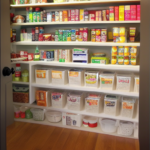If you’ve been intrigued by Marie Kondo’s organizing tips, you’ve come to the right place. We’ve broken down her method for decluttering into actionable steps to follow at home. From folding T-shirts in a systematic manner to making a habit of saying ‘thank you’ to every item, we’ve got you covered.
Marie Kondo’s method of decluttering
Marie Kondo, a Japanese organizing pro, is a master of decluttering and tidying. Her method was first popularized in 2014 with the release of her best-selling book. The book has sold millions of copies and has been published in more than 30 countries. The method focuses on discarding things that don’t spark joy. She also encourages her readers to place items in accessible, visible places instead of keeping them in boxes or drawers.
A world-renowned tidying expert, Marie Kondo guides her clients in sorting through their belongings, choosing the objects that spark joy. Her clients range from retired couples to harried parents of young children. She’s also helped families living in small apartments reclaim space and find new ways to store their belongings.
In addition to decluttering and organizing, Marie Kondo suggests that you reduce the size and quantity of your belongings. Keep like-like items together and in one place, and try to keep only a few pieces of clothing, books, and accessories. She also recommends establishing a dialogue with your home when you clean.
The method is based on the Japanese traditional religion, Shinto, which is based on ritual practices. Among its many beliefs, Shinto holds that most objects are sentient or have a soul. Similarly, Marie Kondo believes that each item has a spiritual value.
The book has been translated into many languages worldwide. Marie Kondo’s method of decluttering has become a global craze and she has become the “decluttering guru” of our time. In the US alone, the book has sold more than eight million copies. She has appeared on several TV shows, including Rachael Ray and Mindy Kaling’s The Mindy Project. In addition, the revival of Gilmore Girls included a joke referring to the method.
Marie Kondo’s method of declogging is based on the Japanese philosophy of keeping things in their proper places. It encourages the owner to keep only the things they love. This method takes months to complete.
Her folding method for T-shirts
If you have a t-shirt collection, Marie Kondo’s folding method for T shirts can help you organize your clothes. This method uses origami-like precision to create a neat, symmetrical package. It also ensures a perfectly fitted T-shirt. This method can be tricky to master, so follow her visual guide carefully.
To fold your T-shirt correctly, begin by folding the right side of the shirt inward. Next, fold the right sleeve back halfway. Now, fold the neckline in, making sure to fold it toward the hemline. After that, fold it in half again. The resulting rectangle should be flat and easy to reach.
The next step in Marie Kondo’s folding method for T shirts involves folding the garment so that it stands up on one end. This will allow you to use the vertical space in your drawers and will allow you to view the clothing you wear frequently. This method is also great for organizing clothes in limited spaces.
After you have folded your T-shirt, you can then place them in your drawers. This method will make them look neater and more appealing. Unlike traditional folding methods, Marie Kondo’s method is simple and straightforward. It involves acknowledging what you have and discarding what doesn’t spark joy.
Marie Kondo’s folding technique for T-shirts has inspired millions of people to tidy their closets. She has also published a book called The Life-Changing Magic of Tidying Up, and has a TV show on Netflix called Tidying Up With Marie Kondo. Her methods have sparked a global obsession with tidying up.
Her rule of keeping only items that spark joy
The first step to applying Marie Kondo’s rule of keeping only what sparks joy is to gather all of the items you own in one place. Next, you will feel each item, asking yourself if it sparks joy. If it doesn’t, then get rid of it.
The next step in applying Marie Kondo’s rule of keeping only what sparks joy is to eliminate any papers. Marie Kondo advocates dumping all paper, with the exception of those with sentimental value or papers that you will use for a limited time. You should also discard any items that are not in use.
Another step in applying Marie Kondo’s rule of keeping only what sparks joy is to identify the items you will keep. While this may sound easy, it is not always so easy. For example, you might have a spare light bulb, or tools that you need to fix something. The latter isn’t likely to spark joy.
The second step is to evaluate the items you have. You might decide to discard some items, while others may choose to keep them. However, it will be easier to do this with less sentimental items. After that, you’ll be left with items that spark joy. Often, people will discard several items and leave only those that spark joy.
In order to make decisions about which items to keep, touch each item carefully. Hold the item in your hands firmly, and try to feel its sensation. If it sparks joy, you’re probably happy keeping it. This way, you’ll avoid having to discard the item.
Another step in implementing the Marie Kondo rule of keeping only items that spark joy is to clean your home. If you’re looking to clear out clutter, it’s important to organize your belongings by category. Kondo recommends grouping like items together. When you’re tidying, she also encourages you to talk to your home.
Her ‘thank you’ to every item
Marie Kondo’s ‘thank you to every item’ technique is an important part of the KonMari method of decluttering. It encourages us to thank each item for its purpose before discarding or donating it. This method helps us show gratitude for our belongings and helps us let go of items that no longer spark joy.
The first step in the KonMari method is to clear away unnecessary clutter. This involves weeding out books, paperwork, and any other items that don’t spark joy. Then, we can start to evaluate each item to see if it has value and joy.













